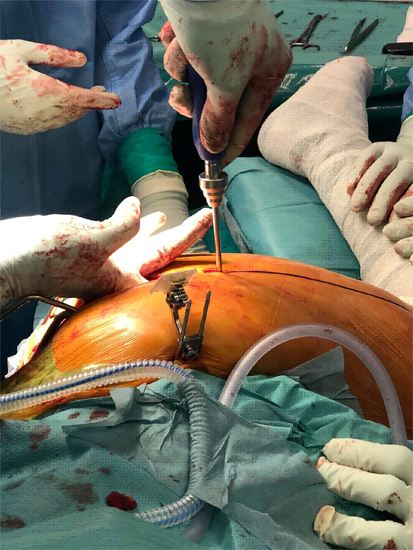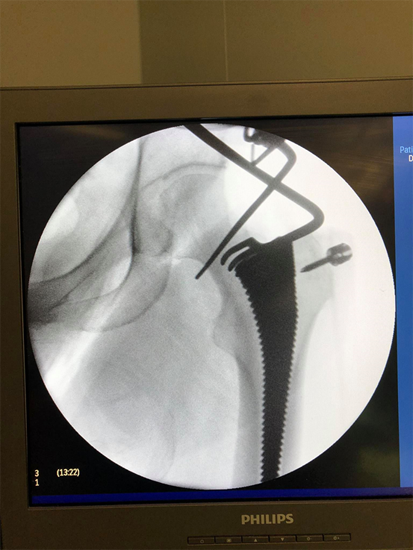Case Report
Volume 2 Issue 1 - 2020
“Navi-superpath”: the Superpath hip Approach for hip Arthritis combined with a Portable Mini-navigation system. A Novel Technique
Metropolitan General Hospital, Greece
*Corresponding Author: Konstantinos Intzoglou, Metropolitan General Hospital, Greece.
Received: June 15, 2020; Published: June 22, 2020
Abstract
The SuperPath approach was first performed in 2007 at the U.S.A. Combination of the SuperPath with navigation systems was till recently impossible. For the first time we managed to combine the SuperPath approach with a portable digital navigation system. The SuperPath is one of the approaches used to perform a Total Hip Arthroplasty in cases of primary or secondary Hip Arthritisand is considered as one of the best minimally invasive procedures. It has a lot of advantages (the hip is never surgically dislocated, no tendon is cut during the procedure, no need for postsurgery restrictions etc.) but a major difficulty –which requires a lot of attention by the surgeon- as well: the acetabular cup orientation/anteversion is affected by the femur’s position during the procedure. Thus, the combined used of the SuperPath and the portable navigation system may eliminate the possibility of malposition of the acetabular cup. Thus, the acetabular cup is fixed at the optimal anteversion/inclination position which is measured in real time resulting in an optimal fixation of the Total Hip Arthroplasty. This way the Total Hip Arthroplasty can last longer and the major complication of this procedure –hip dislocation postsurgically- may be diminished.
Introduction
Successful Total Hip Arthroplasty (THA) is mainly defined by correct femur component anteversion, correct cup fixation and alignment, restoration of leg length and proper hip offset. Navigation is excellent in helping the surgeon determine these angles during the procedure at the theater, in order to achieve the templated, planned goals and provide the patient an excellent hip arthroplasty. All hip minimally invasive procedures give us better immediate postsurgery result [1]; but this comes usually with the cost of reduced visualization of the femur or the acetabulum (depending on the approach). Combined use of the SuperPath (Supercapsular Percutaneously Assisted Total Hip) approach for THA with a portable mini-navigation system has never been done before, and may solve problems that arise from reduced visualization of the acetabulum; the main concern in the SuperPath approach [2].
Method
The patient 64 yo woman (75kg, 170cm), was suffering from left hip pain, and was scheduled for a SuperPath (Microport) Arthroplasty with the combined use of portable mini-navigation system (Naviswiss), for which she gave us her informed concent. The mini Navigation system consists of a portable, handheld, light device which is kept by the surgeon during surgery and some miniature precision tracking tags. A tag is fixed at the Anterior Superior Iliac Spine via two small 3mm pins and another tag (the F-Tag) is fixed via a single pin, screwed at the greater trochanter (Picture 1). A third tag is attached via a magnet at the cup impactor provided by the Arthroplasty Company (MicroPort).

Picture 1: The screwdriver can be seen here during its establishment for later installation of the F-Tag.
We started the SuperPath approach traditionally with a skin incision from the greater trochanter and 6-8 cm proximally in line with the femur, when the leg is in the “home position” (80? of hip flexion, 20? of hip rotation and slight adduction). The gluteus maximus was splitted bluntly, by dissectting it with the digital finger. After incising the bursa above the capsule, the capsule was incised along the axis of the femur and in line to the femoral neck and 1 cm proximal to the acetabular rim. Femoral broaching comes next until the appropriate size is reached, having the neck and the head intact.
All navigation tags were now applied. Special care was taken for the F-tag (the one on the greater trochanter) not to interfere with the femoral broach. In this patient we easily managed to establish the f-tag, while in “home” position” and via the main incision of the SuperPath. It seems though that some times, when skin won’t permit it, application via an extra stab incision will be necessary.
The baseline for leg length and offset was subsequently measured with the navigation system after attaching the F-tag to the single-pin interface. Before neck osteotomy we verified our height with the c-arm, also checking this way the position of the F-Tag (Picture 2). Next, neck osteotomy was performed using the proximal part of the femoral broach as a guide. Acetabular reaming via the small extra stab incision of the SuperPath was performed. Simutaneous check of the inclination and anteversion of the reamer is possible and vital. Given the fact that the acutabular reamer of the SuperPath is hemispherical and the actual component is elliptical, slight (up to 10 degrees) differences from the final component fixation are acceptable.
Cup alignment was navigated with the navigation system by attaching the M-tag to the original cup inserter provided by the implant manufacturer. Acetabular component was impacted using the mini-navigation system and liner was inserted as well. Trial reduction was performed with the femoral broach in place. C-arm verification was done as well. The navigation was used at this point in order to fine tune and achieve templated goals of offset and leg length discrepancy. Neck and offset was changed accordingly with the trials in place. Final non-cement femur component was introduced and impacted in final position. Finally, the joint was reduced and the F-tag attached to the femur again to re-measure and document post-operative leg length and offset.
Discussion
The SuperPath is a modern hip approach, which belongs to the minimally invasive procedures of the hip, uses the interval between the piriformis muscle and the gluteus minimus and medius muscle in order to access the hip capsule from above, and was first described by Chow et al [3]. It was developed to promote early mobilization, preservation of the hip capsule, better pain control and greater range of motion.
Combined use of the SuperPath approach and a portable mini-navigation system has never been done before. It is an excellent evolution to Total Hip Arthroplasty, as it gives the surgeon an extra verification of the acetabulum position. Given the fact that the SuperPath approach is a procedure that -by its nature- provides excellent visualization of the femur anteversion, this combination (the SuperPath approach combined with a mini-navigation system) gives the surgeon an excellent and reproducible combined anteversion. The mini-navigation system has also the advantage of portability, light weight, ease of use and can all be controlled by the surgeon himself in the surgery field, with the use of a special designed, single-use, sterilized bag.
Advantages of the SuperPath
- Preservation of the hip capsule. All mechanoreceptors are preserved as well. Thus, patients may describe a more “natural” feeling post surgically.
- No abnormal movement of the hip during the procedure; no necessity for intraoperative dislocation of the hip as well.
- No need for special curved instruments, therefore no danger for skin ischemia and necrosis, which is a concern with all others minimally invasive procedures.
- No need for special table (traction, radiolucent table etc.).
- Preservation of all muscles around the hip.
- Minimum need for blood transfusion post surgically (3,3%). [4]
- Learning curve that diminishes risks for the patients, since at any time the SuperPath approach can be transformed to a conventional posterior approach by extending the approach posteriorly and cutting the piriformis and all external rotator muscles of the hip. This ease of transformation of the SuperPath approach is a unique feature as well [5], for the rare complication of the femur fracture during the procedure. In this case the fixation and osteosynthesis of the femur is easily done by extending the approach to a conventional posterior one.
Disadvantages of the Super Path
- Limited view of the proximal femur, and the lesser trochanter in particular
- Dicreased view of the acetabulum compared to traditional approaches (Moore etc.)
C-arm use during the procedure and use of the greater trochanter –instead of the traditional lesser one- as a landmark addresses the first disadvantage. Combination of navigation and SuperPath approach diminishes the disadvantage of limited view of the acetabulum and ensures reproducible results as far as the orientation of the acetabular component is concerned.
The SuperPath approach is an approach “from above”. All other approaches of the hip are either “from the front” or “from the back”. All orthopaedic residents throughout the world are educated in these two last ways of approaching the hip. The SuperPath is a completely different approach; it is “from above”. It actually resembles a hip nail, as far as the way the femur broaching is performed. Thus, all orthopaedic surgeons have learn to think and perform a hip arthroplasty either from anterior or from posterior. In order to perform and eventually adopt the SuperPath one has to change his way of thinking, and of course be specially educated. The now availability and combination of the SuperPath approach with mini-navigation system (“NAVI-SuperPath”) make things even easier for anyone to adopt the aforementioned technique for addressing hip Arthritis surgically.
References
- Mouilhade F, Matsoukis J, Oger P et al. (2011). Component Positioning in Primary Total Hip Replacement: A Prospective Comparative Study of Two Anterolateral Approaches, Minimally Invasive Versus Gluteus Medius Hemimyotomy. Orthop Traumatol Surg Res Feb; 97(1): 14-21.
- Jun Xie, Hongxi Zhang, Lei Wang. (2017). Comparison of supercapsular percutaneously assisted approach total hip versus conventional posterior approach for total hip arthroplasty: a prospective, randomized controlled trial. J Orthop Surg Res. 12: 138.
- Chow J, Penenberg B, Murphy S. (2011). Modified micro-superior percutaneously-assisted total hip: early experiences & case reports. Curr Rev Musculoskelet Med 4: 146-50.
- Gofton W, Chow J, Olsen KD et al. (2015). Thirty-day readmission rate and discharge status following total hip arthroplasty using the supercapsular percutaneously-assisted total hip surgical technique. Int Orthop. May; 39(5): 847-51.
- Rasuli KJ, Gofton W. (2015). Percutaneously assisted total hip (PATH) and Supercapsular percutaneously assisted total hip (SuperPATH) arthroplasty: learning curves and early outcomes. Ann Transl Med. Aug; 3(13): 179.
Citation: Konstantinos Intzoglou. (2020). “Navi-superpath”: the Superpath hip Approach for hip Arthritis combined with a Portable Mini-navigation system. A Novel Technique. Journal of Orthopaedic and Trauma Care 2(1). DOI: 10.5281/zenodo.3906128
Copyright: © 2020 Konstantinos Intzoglou. This is an open-access article distributed under the terms of the Creative Commons Attribution License, which permits unrestricted use, distribution, and reproduction in any medium, provided the original author and source are credited.

